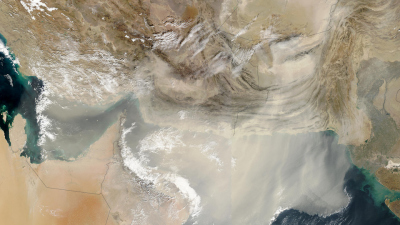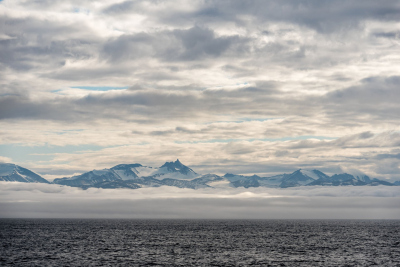- Home
- Discover
- Media Releases
- Media Releases 2020
- Dust archive
Dust in west Asia provides evidence for ice melting

A minor trigger can be sufficient to change the climate worldwide. In the past, especially during the last glaciation and following its end about 20,000 years ago, the melting of ice in the northern hemisphere, for example, during the Heinrich Events and the Younger Dryas, altered ocean circulation rather abruptly and thus also affected the wind currents in the atmosphere. These changes can be detected in sediment samples from semi-arid and arid regions of the Earth - for example, in southeastern Iran.
Dr. Mahyar Mohtadi and his colleagues examined a sediment core from a peat bog in this region. Based on the elemental composition of the core they were able to reconstruct a dust record that covered a period of 12,000 years, from 19,000 to 7,000 years ago. This encompasses the transition from the Pleistocene to the Holocene, and includes the abrupt cold events in the North Atlantic region at the end of the last glaciation.
This core provides the scientists with a high-resolution dust archive because the individual particles have been preserved. "This is rare. Normally, in sandstorm regions the dust simply blows away because it is so dry," explains Mahyar Mohtadi. The moorland near the city of Jiroft is an exception. The dust was trapped and deposited here in this wetland area, and provides the basis for reconstructing the occurrence of winter storms in the past. Previously, only data for summer monsoon precipitation had been obtained from this area, but not for the winter dust transported by the westerly winds, which are a component of the global wind system. The region of southeastern Iran is important for the climate because atmospheric circulation here is extremely variable depending on the season. "We wanted to know when the various wind systems were dominant for the climate in this region," says Mohtadi. He and his colleagues were able to temporally link the occurrence of dust and its origins with the cooling events several thousand kilometers away.
When ice melts in the North Atlantic on a large scale, the resulting influx of freshwater weakens the global ocean conveyor belt, which can be accelerated or slowed down by the salinity and temperature of the water. At the beginning of each cold event, as explained in the publication, the amount of dust transported eastward from the Arabian Peninsula and northern Africa abruptly increases. This indicates that the collapse of the ocean circulation causes the westerly winds to shift southward. At the end of the events, the storms abruptly diminish and there is a corresponding reduction in the amount of dust transported. "Because the winds are so strongly dependent on ocean circulation in the North Atlantic, our results indicate that the North American ice sheets have influenced the winter climate in western Asia more strongly than the Scandanavian ice sheets have," explains Mahyar Mohtadi. This could be associated with the flow pattern of the Gulf Stream along the eastern coast of North America. Due to freshwater influx and iceberg runoff it reacted more sensitively and rapidly.
Contact:
Dr. Mahyar Mohtadi
Marine Sedimentology
Email: [Bitte aktivieren Sie Javascript]
MARUM produces fundamental scientific knowledge about the role of the ocean and the ocean floor in the total Earth system. The dynamics of the ocean and the ocean floor significantly impact the entire Earth system through the interaction of geological, physical, biological and chemical processes. These influence both the climate and the global carbon cycle, and create unique biological systems. MARUM is committed to fundamental and unbiased research in the interests of society and the marine environment, and in accordance with the Sustainable Development Goals of the United Nations. It publishes its quality-assured scientific data and makes it publicly available. MARUM informs the public about new discoveries in the marine environment and provides practical knowledge through its dialogue with society. MARUM cooperates with commercial and industrial partners in accordance with its goal of protecting the marine environment.
Reza Safaierad, Mahyar Mohtadi, Bernd Zolitschka, Yusuke Yokoyama, Christoph Vogt, Enno Schefuß: Elevated dust depositions in West Asia linked to ocean-atmosphere shifts during North Atlantic cold events. PNAS 2020. DOI: https://www.pnas.org/cgi/doi/10.1073/pnas.2004071117



